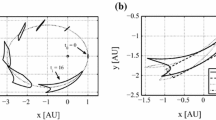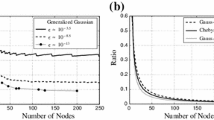Abstract
This paper presents a tool for the numerical propagation of high-fidelity astrodynamics, called PHiFA. The coupled orbit-attitude dynamics for space objects are modeled by considering various types of perturbative forces and torques. Two methods have been implemented to calculate the surface forces: the area matrix method and the beam method. The beam method is more precise as it discretizes the source media (e.g., sunlight and aerodynamic wind) and the surface of the target into multiple rays and finite elements, respectively, and then accumulates the effect of each hit. The PHiFA tool was tested and validated using a 3U CubeSat model and the defunct European environment satellite (Envisat) model.

Similar content being viewed by others
References
Channumsin, S., Jaturutd, S. Analysis of coupled attitude and orbit dynamics for uncontrolled re-entry satellite. In: Proceedings of the 7th International Electrical Engineering Congress, 2019: 1–4.
Sagnières, L. B. M., Sharf, I. Long-term rotational motion analysis and comparison to observations of the inoperative Envisat. Journal of Guidance, Control, and Dynamics, 2018, 42(2): 364–376.
Fruh, C., Kelecy, T. M., Jah, M. K. Coupled orbit-attitude dynamics of high area-to-mass ratio (HAMR) objects: Influence of solar radiation pressure, Earth’s shadow and the visibility in light curves. Celestial Mechanics and Dynamical Astronomy, 2013, 117(4): 385–404.
Kikuchi, S., Howell, K. C., Tsuda, Y., Kawaguchi, J. Orbit-attitude coupled motion around small bodies: Sun-synchronous orbits with Sun-tracking attitude motion. Acta Astronautica, 2017, 140: 34–48.
Bai, X., Junkins, J. L. Integration of the coupled orbit-attitude dynamics using modified Chebyshev-Picard iteration methods. CMES, 2016, 111(2): 129–146.
Li, Q., Wang, B., Deng, Z., Ouyang, H., Wei, Y. A simple orbit-attitude coupled modelling method for large solar power satellites. Acta Astronautica, 2018, 145: 83–92.
Hatten, N., Russell, R. P. Semianalytical technique for six-degree-of-freedom space object propagation. Journal of Guidance, Control, and Dynamics, 2018, 42(2): 217–228.
Gómez, N. O., Walker, S. J. I. Earth’s gravity gradient and eddy currents effects on the rotational dynamics of space debris objects: Envisat case study. Advances in Space Research, 2015, 56(3): 494–508.
Kucharski, D., Kirchner, G., Bennett, J. C., Lachut, M., Sosnica, K., Koshkin, N., Shakun, L., Koidl, F., Steindorfer, M., Wang, P., et al. Photon pressure force on space debris topex/poseidon measured by satellite laser ranging. Earth and Space Science, 2017, 4(10): 661–668.
Liedahl, D., Rubenchik, A., Libby, S., Nikolaev, S., Phipps, C. Pulsed laser interactions with space debris: Target shape effects. Advances in Space Research, 2013, 52(5): 895–915.
Wilken, J. Modelling of laser-based thrust generation for space debris removal. Master Thesis. Technical University of Braunschweig, Institute of Aerospace Systems, Germany, 2015.
Kucharski, D., Kirchner, G., Koidl, F., Fan, C. B., Carman, R., Moore, C., Dmytrotsa, A., Ploner, M., Bianco, G., Medvedskij, M., et al. Attitude and spin period of space debris envisat measured by satellite laser ranging. IEEE Transactions on Geoscience and Remote Sensing, 2014, 52(12): 7651–7657.
Shan, M., Guo, J., Gill, E. Review and comparison of active space debris capturing and removal methods. Progress in Aerospace Sciences, 2016, 80: 18–32.
Vallado, D. A., McClain, W. D. Fundamentals of Astrodynamics and Application. Microcosm Press, 2001.
Gottlieb, R. G. Fast gravity, gravity partials, normalized gravity, gravity gradient torque and magnetic field: derivation, code and data. NASA CR-188243, 1993.
Thébault, E., Finlay, C. C., Beggan, C. D., Alken, P., Aubert, J., Barrois, O., Bertrand, F., Bondar, T., Boness, A., Brocco, L., et al. International geomagnetic reference field: the 12th generation. Earth, Planets and Space, 2015, 67: 79.
Gómez, N. O. Eddy currents applied to space debris objects. Ph.D. Dissertation. University of Southampton, UK, 2017.
Gómez, N. O., Walker, S. J. Eddy currents applied to de-tumbling of space debris: Analysis and validation of approximate proposed methods. Acta Astronautica, 2015, 114: 34–53.
Schmidt, J. D. Numerical Simulation of Optical Wave Propagation with Examples in MATLAB. Bellingham, USA: SPIE Press, 2010.
McInnes, C. R. Solar Sailing: Technology, Dynamics and Mission Applications, Astronomy and Planetary Sciences. London, UK: Springer, 1999.
Vokrouhlický, D., Bottke, W. F., Chesley, S. R., Scheeres, D. J., Statler, T. S. The Yarkovsky and YORP effects. arXiv:1502.01249, 2015. Available at http://de.arxiv.org/pdf/1502.01249.
Loeb, N. G., Wielicki, B. A., Doelling, D. R., Louis Smith, G., Keyes, D. F., Kato, S., Manalo-Smith, N., Wong, T. Toward optimal closure of the Earth’s top-of-atmosphere radiation budget. Journal of Climate, 2009, 22(3): 748–766.
Lyle, R., Stabekis, P. Spacecraft aerodynamic torques. NASA SP-8058, 1971.
He, C., Yang, Y., Carter, B., Kerr, E., Wu, S., Deleflie, F., Cai, H., Zhang, K., Sagnières, L., Norman, R. Review and comparison of empirical thermospheric mass density models. Progress in Aerospace Sciences, 2018, 103: 31–51.
Hughes, P. C. Spacecraft Attitude Dynamics. Dover Publications, 2012.
Montenbruck, O., Gill, E. Satellite Orbits: Models, Methods, and Applications. Berlin, Heidelberg: Springer, 2000.
Ries, J., Bettadpur, S., Eanes, R., Kang, Z., Ko, U., McCullough, C., Nagel, P., Pie, N., Poole, S., Richter, T., Save, H., Tapley, B. Development and evaluation of the global gravity model GGM05. Report No. CSR-16–02, Center for Space Research, The University of Texas at Austin, USA, 2016.
Folkner, W. M., Williams, J. G., Boggs, D. H., Park, R. S., Kuchynka, P. The planetary and lunar ephemerides DE430 and DE431. Interplanetary Network Progress Report, 2014, 196: 1–81.
Wheeler, P. C. Magnetic attitude control of rigid, axially symmetric, spinning satellites in circular Earth orbits. NASA CR-313, 1965.
Bernath, P. F., McElroy, C. T., Abrams, M. C., Boone, D., Butler, M., Camy-Peyret, C., Carleer, M., Clerbaux, C., Coheur, P.-F., Colin, R., et al. Atmospheric chemistry experiment (ACE): Mission overview. Geophysical Research Letters, 2005, 32: L15S01.
Ojakangas, G. W., Anz-Meador, P., Cowardin, H. Probable rotation states of rocket bodies in low Earth orbit. In: Proceedings of the 14th Annual Maui Optical and Space and Surveillance Technologies Conference, 2012.
Omar, K. H. Simultaneous orbital and attitude propagation of satellites in low-Earth orbit using CUDA for aerodynamics simulation. In: Proceedings of the 55th AIAA Aerospace Sciences Meeting, 2017.
Yang, Y., Klein, E., Sagnières, L. Tumbling object deorbiting using spaceborne laser engagement—A CubeSat case study. Advances in Space Research, 2020, 65(7): 1742–1757.
Acknowledgements
We would like to acknowledge the support from the Guangdong Basic and Applied Basic Research Foundation Project (No. 2020A1515110216) and the support of the Cooperative Research Center for Space Environment Management (SERC Limited) through the Australian Government’s Cooperative Research Center Program when the work was initialized. We would also like to appreciate Dr. Daniel Kucharski from The University of Texas at Austin for sharing the fitted spin period values of Envisat based on satellite laser ranging measurements.
Author information
Authors and Affiliations
Corresponding author
Ethics declarations
The authors have no competing interests to declare that are relevant to the content of this article.
Additional information
Yang Yang was previously an assistant professor at the School of Aeronautics and Astronautics, Sun Yat-sen University, Shenzhen, China, during 2020–2021. He used to work as a postdoctoral research fellow at SPACE Research Centre, RMIT University, Melbourne, Australia, during 2015–2019. His doctoral degree was with the School of Astronautics, Northwestern Polytechnical University, Xi’an, China, during 2010–2015. His current research interests include astrodynamics, data association, orbit determination & prediction, nonlinear and non-Gaussian estimation/filtering, space situational awareness, and GNSS based positioning & applications.
Erik Klein is currently a Ph.D. student at the Institute of Space Systems, German Aerospace Center (DLR) Bremen, Germany. He used to work as a master student at the Institute for Space Systems, TU Braunschweig, Braunschweig, Germany, and visited SPACE Research Centre, RMIT University, Melbourne, Australia, from Oct. 2018 to Apr. 2019. His master thesis “Influence of laser-matter interaction on resident space objects” was supported by both universities.
Changyong He received his B.S. degree in geomagnetics and M.S. degree in GPS navigation and positioning from Wuhan University, Wuhan, China, in 2011 and 2013, respectively, and his Ph.D. degree from RMIT University, Melbourne, Australia, in 2019. He is currently working at IGN/ENSG in France. His research interest includes the modeling of the thermospheric mass density, precise orbit determination, GPS meteorology, space geodesy, and the terrestial coordinate framework.
Han Cai received his Ph.D. degree in geospatial science from RMIT University, Melbourne, Australia, in 2019, and was a postdoctoral research fellow at the Oden Institute for Computational Engineering and Sciences, The University of Texas at Austin, from 2019 to 2021. In 2021, he joined Beijing Institute of Technology as an assistant professor. His areas of expertise are in orbit determination, multi-target tracking, sensor tasking, information fusion, and uncertainty quantification.
Yan Zhang is currently a full professor at the School of Aeronautics and Astronautics, Sun Yat-sen University, Shenzhen, China. She received her doctoral degree of aerospace science and technology from National University of Defense Technology, Changsha, China, in 2005. She has published more than 40 journal/conference papers and 4 monographs. Her main research interests include photoelectric devices design and information fusion techniques.
Rights and permissions
About this article
Cite this article
Yang, Y., Klein, E., He, C. et al. PHiFA—A tool for numerical propagation of high-fidelity astrodynamics. Astrodyn 6, 189–204 (2022). https://doi.org/10.1007/s42064-021-0113-1
Received:
Accepted:
Published:
Issue Date:
DOI: https://doi.org/10.1007/s42064-021-0113-1




